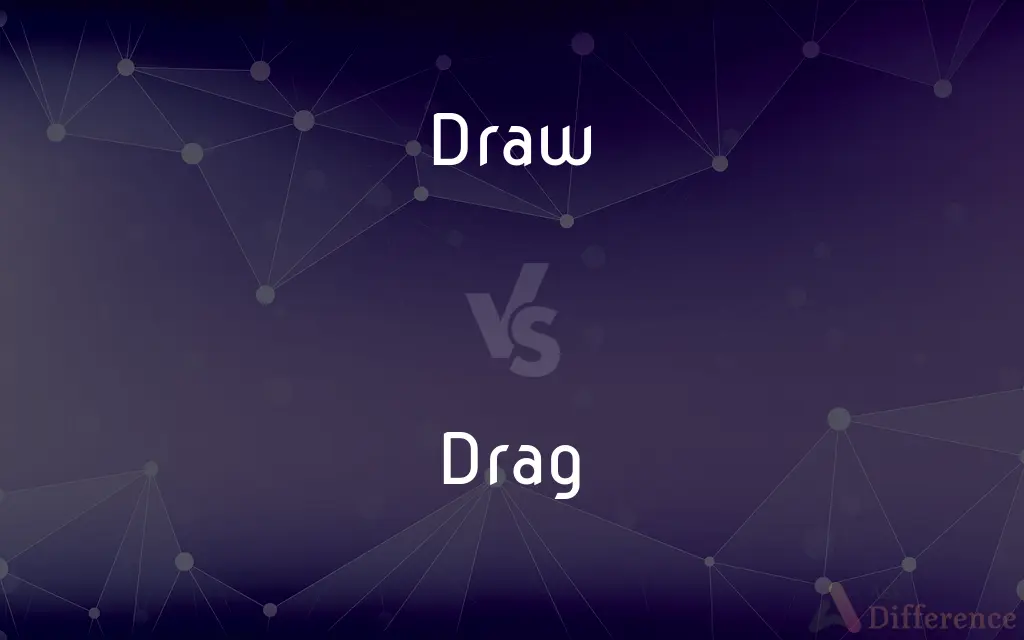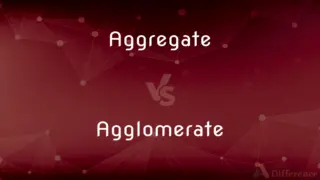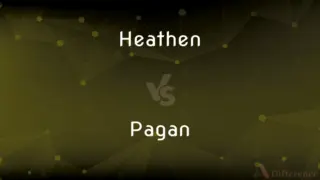Draw vs. Drag — What's the Difference?
By Tayyaba Rehman & Fiza Rafique — Updated on March 5, 2024
Draw refers to pulling with continuous force, often associated with artistic creation or moving something towards oneself. Drag involves pulling with resistance, typically on a surface or through a medium, emphasizing effort or difficulty.

Difference Between Draw and Drag
Table of Contents
ADVERTISEMENT
Key Differences
Draw often connotes a gentler action, such as pulling something towards oneself or using a pencil or brush to create art, where the movement is intentional and controlled. In contrast, drag implies a forceful pulling action that encounters resistance, whether moving something heavy across the ground or through water, highlighting the effort involved and the interaction with the environment.
In art, to draw means to produce images, lines, or shapes on a surface, creating visual art with tools like pencils or brushes. Drag, however, does not have a direct association with artistic creation but can be used metaphorically to describe a slow, laborious process, as in dragging through a difficult task.
When discussing user interfaces or software, draw can refer to rendering visuals on a screen, as in drawing graphics or text. On the other hand, drag is used to describe the action of clicking and holding to move objects within the software environment, emphasizing the motion and effort to reposition elements.
In physical contexts, draw can also mean to pull something towards oneself or to extract, as in drawing water from a well, where the action involves overcoming minimal resistance. Drag, by contrast, often involves a greater degree of physical effort, as when dragging heavy furniture across a room, where friction and weight add to the difficulty of the task.
Despite their differences, both terms imply a form of movement initiated by force. While draw often suggests a smoother, more controlled action, drag indicates a more strenuous effort, often with notable resistance or friction.
ADVERTISEMENT
Comparison Chart
Definition
Pulling with continuous force; artistic creation.
Pulling with resistance; moving with effort.
Connotation
Gentleness, control, creativity.
Effort, resistance, difficulty.
Associated Actions
Pulling towards, sketching, extracting.
Pulling across or through, repositioning.
Examples
Drawing a picture, drawing water from a well.
Dragging furniture, drag and drop in UI.
Contexts
Art, extraction, software rendering.
Physical movement, software interaction.
Compare with Definitions
Draw
To pull gently towards oneself.
She drew the curtain open.
Drag
To pull something across a surface with effort.
They dragged the sofa to the other side of the room.
Draw
To pull out or extract something.
Drawing water from a well requires strength.
Drag
In computing, to move objects on a screen.
Drag and drop the file into the folder.
Draw
To attract or pull in.
The festival drew large crowds.
Drag
To move slowly with difficulty.
The meeting dragged on for hours.
Draw
To produce images or marks on a surface.
He loves to draw landscapes.
Drag
To force someone to go somewhere.
She was dragged to the party against her will.
Draw
In software, to render visual elements.
The program draws the chart on the screen.
Drag
To search or sweep the bottom of a body of water.
The team dragged the lake for evidence.
Draw
Pull or drag (something such as a vehicle) so as to make it follow behind
A cart drawn by two horses
Drag
Pull (someone or something) along forcefully, roughly, or with difficulty
We dragged the boat up the beach
Draw
Extract (an object) from a container or receptacle
He drew his gun and peered into the gloomy apartment
Drag
(of time) pass slowly and tediously
The day dragged—eventually it was time for bed
Draw
Take or obtain (liquid) from a container or receptacle
He drew off a pint of bitter
A wheel was built to draw water from the well
Drag
The action of pulling something forcefully or with difficulty
The drag of the current
Draw
An act of drawing on a cigarette or cigar
She took a long draw on her cigarette
Drag
A device, such as a grappling hook, that is used for dragging under water.
Draw
To represent by lines drawn; to form a sketch or a picture of; to represent by a picture; to delineate; hence, to represent by words; to depict; to describe.
A flattering painter who made it his careTo draw men as they ought to be, not as they are.
Can I, untouched, the fair one's passions move,Or thou draw beauty and not feel its power?
Drag
(nautical) The difference between the speed of a screw steamer under sail and that of the screw when the ship outruns the screw; or between the propulsive effects of the different floats of a paddle wheel.
Draw
To pull; to exert strength in drawing anything; to have force to move anything by pulling; as, a horse draws well; the sails of a ship draw well.
Drag
To move onward heavily, laboriously, or slowly; to advance with weary effort; to go on lingeringly.
Time seems to drag when you're waiting for a bus.
Draw
A lot or chance to be drawn.
Drag
The act of dragging; anything which is dragged.
Draw
Pull (a person) apart with four horses tied to his extremities, so as to execute him;
In the old days, people were drawn and quartered for certain crimes
Drag
The act of dragging (pulling with force);
The drag up the hill exhausted him
Draw
Pull back the sling of (a bow);
The archers were drawing their bows
Drag
Force into some kind of situation, condition, or course of action;
They were swept up by the events
Don't drag me into this business
Draw
Flatten, stretch, or mold metal or glass, by rolling or by pulling it through a die or by stretching;
Draw steel
Drag
Proceed for an extended period of time;
The speech dragged on for two hours
Common Curiosities
Can you drag something without touching it?
In physical contexts, dragging usually requires direct contact. In digital environments, however, "dragging" describes moving virtual objects without physical touch.
Can both drawing and dragging be used in digital contexts?
Yes, drawing refers to rendering visuals on a screen, while dragging is about moving objects within a software environment.
Does drawing always involve art?
Not exclusively; drawing can also mean pulling towards oneself or extracting, though it is commonly associated with art.
Is dragging always a physical action?
While primarily physical, dragging can also describe slow, tedious processes or actions in software, indicating effort or difficulty.
Can the terms draw and drag be used interchangeably in any context?
Due to their distinct connotations and uses, they are not typically interchangeable, though both involve a form of pulling.
How does technology change the meaning of draw and drag?
Technology introduces new meanings, with drawing related to graphic creation and dragging to moving objects in a digital environment, expanding their traditional definitions.
Does drawing require specialized tools?
While it can be done with basic tools like pencils and paper, specialized tools can enhance the drawing experience, especially in professional or artistic contexts.
What is the main difference between drawing and dragging?
Drawing often implies a controlled, gentle action or the act of artistic creation, while dragging suggests moving something with effort against resistance.
Is it easier to draw or drag an object?
Generally, drawing is considered easier if it involves less resistance, while dragging is seen as harder due to the effort required to overcome resistance.
Is dragging more physically demanding than drawing?
Typically, yes, because dragging involves overcoming resistance, making it more strenuous compared to the generally lighter, controlled action of drawing.
How does the concept of resistance differentiate drawing from dragging?
Drawing implies minimal to no resistance, focusing on control and intention, whereas dragging involves significant resistance, emphasizing effort.
Do both actions require a similar amount of force?
The force required can vary widely; drawing can be gentle or require minimal force, while dragging often demands more physical effort due to resistance.
How do drag and draw relate to efficiency in tasks?
Efficiency in drawing relates to skill and technique, often leading to quicker, more precise creations. Efficiency in dragging is about minimizing effort and resistance, possibly through the use of tools or techniques to ease the process.
Can animals draw or drag?
Animals can drag objects or others, showcasing effort, but drawing, in the artistic sense, is uniquely human, though some animals may make marks that humans interpret as drawings.
Can drag have a negative connotation?
Yes, drag can imply reluctance, resistance, or tediousness, as in dragging one's feet or a meeting that drags on.
Share Your Discovery

Previous Comparison
Aggregate vs. Agglomerate
Next Comparison
Heathen vs. PaganAuthor Spotlight
Written by
Tayyaba RehmanTayyaba Rehman is a distinguished writer, currently serving as a primary contributor to askdifference.com. As a researcher in semantics and etymology, Tayyaba's passion for the complexity of languages and their distinctions has found a perfect home on the platform. Tayyaba delves into the intricacies of language, distinguishing between commonly confused words and phrases, thereby providing clarity for readers worldwide.
Co-written by
Fiza RafiqueFiza Rafique is a skilled content writer at AskDifference.com, where she meticulously refines and enhances written pieces. Drawing from her vast editorial expertise, Fiza ensures clarity, accuracy, and precision in every article. Passionate about language, she continually seeks to elevate the quality of content for readers worldwide.













































